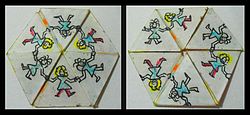
Back ফ্লেক্সাগন Assamese Flexàgon Catalan Flexagon German Flexágono Spanish Flexagone French פלקסגון HE Flexagono Italian Flexágonos Portuguese Flexagon Romanian Флексагон Russian

In geometry, flexagons are flat models, usually constructed by folding strips of paper, that can be flexed or folded in certain ways to reveal faces besides the two that were originally on the back and front.
Flexagons are usually square or rectangular (tetraflexagons) or hexagonal (hexaflexagons). A prefix can be added to the name to indicate the number of faces that the model can display, including the two faces (back and front) that are visible before flexing. For example, a hexaflexagon with a total of six faces is called a hexahexaflexagon.
In hexaflexagon theory (that is, concerning flexagons with six sides), flexagons are usually defined in terms of pats.[1][2]
Two flexagons are equivalent if one can be transformed to the other by a series of pinches and rotations. Flexagon equivalence is an equivalence relation.[1]
- ^ a b Oakley, C. O.; Wisner, R. J. (March 1957). "Flexagons". The American Mathematical Monthly. 64 (3). Mathematical Association of America: 143–154. doi:10.2307/2310544. JSTOR 2310544.
- ^ Anderson, Thomas; McLean, T. Bruce; Pajoohesh, Homeira; Smith, Chasen (January 2010). "The combinatorics of all regular flexagons". European Journal of Combinatorics. 31 (1): 72–80. doi:10.1016/j.ejc.2009.01.005.
© MMXXIII Rich X Search. We shall prevail. All rights reserved. Rich X Search